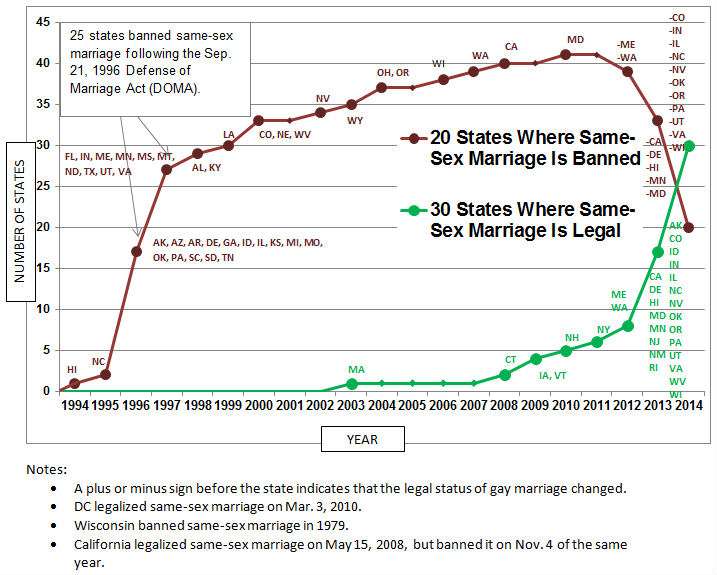Both Gay and Heterosexual Marriages Are Equally Stable
It's past time for gays and lesbians to be given the opportunity to wed. The evidence suggests that they will do no worse in marriage than their fellow heterosexual citizens have done.

Polls show that nearly 60 percent of Americans approve of same-sex marriage, which is now legal in 30 states. Even the Vatican, halfway through its two-week Synod on family life, issued a preliminary statement this week recognizing that gays and lesbians have "gifts and talents to offer the Christian community" and acknowledging the "mutual aid" same-sex couples provide one another.
Some gay men and lesbians want to get married as a public confirmation of their commitment to one another. There are also the legal advantages afforded married couples, such as inheritance tax benefits and hospital visitation rights. Now the Stanford sociologist Michael Rosenfeld has identified another big advantage: relationship stability.
In a September study in the Journal of Marriage and Family, Rosenfeld uses time series data from the How Couples Meet and Stay Together survey (HCMST) to probe the longevity and breakup rates of America's marriages. The HCMST, which began in 2009, is a nationally representative survey of 3,009 couples, of which 471 are same-sex. Rosenfeld's paper reports the breakup rate of the couples surveyed annually through 2012.
Marriage in the study is conventionally defined by legal recognition for heterosexual couples. Since the federal government did not recognize same-sex marriages before the Supreme Court's 2013 decision overturning Article 3 of the Defense of Marriage Act, Rosenfeld more broadly defines same-sex marriage and marriage-like arrangements as including state recognition, civil unions, and domestic partnerships. Also included are same-sex couples who answered "yes" when asked if they were married "even if the government may not recognize your marriage."
As Rosenfeld notes, most prior studies of same-sex marital stability focused on European countries that had approved same-sex civil unions and marriages years earlier. A 2006 Swedish study, for example, found that gay male couples had a dissolution rates similar to that of heterosexual couples, whereas the breakup rate among lesbian couples was two to three times higher. Rosenfeld cites a paper that followed the marriage outcomes of couples in Vermont for three years after that state approved civil unions for same-sex couples. "Over 3 years, the same-sex couples without civil unions had the highest rate of break-up (9.3 percent), followed by same-sex couples with civil unions (3.8 percent) and heterosexual married couples (2.7 percent)," he reports. He adds that the Vermont study "is one important demonstration of the association between relationship formalization and couple stability for same-sex couples."
In the HCMST survey, there are 1,899 heterosexual married couples and 639 unmarried heterosexual couples, who had been together an average of 22.9 and 6 years, respectively. Same-sex married couples numbered 165 and unmarried 306, who had correspondingly been together an average of 16 and 11 years. There were 70 gay male married couples and 95 lesbian married couples.

Rosenfeld analyzed various factors that might have an impact on marriage longevity, including income, age, race, educational level, presence of children in the household, and parental approval of the matches. None of these considerations played a large role in accounting for couple longevity. Being married or unmarried was the crucial variable.
The breakup rate in Rosenfeld's study was determined by dividing the number of years that each cohort remained together by the number of breakups over the four year period of the survey. Among the HCMST participants, married and unmarried, the overall annual break-up rate was 4.9 percent for heterosexual couples and 8.3 percent for same-sex couples.
Not too surprisingly, there are big differences in relationship stability between married and unmarried heterosexual couples. The annual breakup rate among married different-sex couples was 1.5 percent. The relationships of unmarried different-sex couples dissolved at annual rate of 21.7 percent.
Married same-sex couples broke up at a rate of 2.6 percent per year, while 12.8 percent of unmarried same-sex couples went their separate ways annually. Interestingly, Rosenfeld notes that "lesbian couples have a significantly higher rate of break-up compared to heterosexual couples, while gay male couples have a break-up rate that is not distinguishable from the break-up rate of heterosexual couples." It is also noteworthy that unmarried same-sex couples broke up at about half the rate of unmarried different-sex couples. It is likely that part of the reason for this disparity is that unmarried same-sex couples had already been together almost twice as long their different-sex counterparts at beginning of the survey.
In the initial 2009 HCMST survey, 42 percent of the same sex couples living in states that recognized their relationships were married whereas only 28 percent were so in other states. This prompts Rosenfeld to observe, "Although the stability associated with marriage appears not to depend on state recognition of the marriage, state recognition of same-sex marriage opens a pathway to higher marriage rates among same-sex couples."
Rosenfeld concludes, "Despite the declining universality of marriage in the US for heterosexual couples, marriage is a uniquely important predictor of couple stability, for both heterosexual and for same-sex couples." Rosenfeld finds that marriage is not just associated with stability but causes it—that once couples are legally entangled, that serves as a significant barrier to exit.
It's way past time for gays and lesbians to be given the opportunity to wed. The evidence suggests that they will do no worse in marriage than their fellow heterosexual citizens have done.
Disclosure: My wife and I are long-time supporters of Equality Virginia.


Show Comments (123)